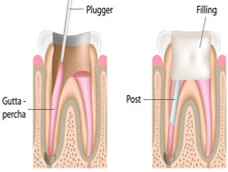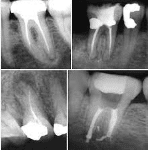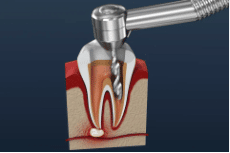A toothache can signify something is wrong with the tooth or tooth structure. More often than not, a toothache is caused by an infection in the tooth or a problem with the jawbone. There are multiple reasons behind tooth pain. It may be due to tooth decay or any other infection leading to tooth decay. In most cases, dentists kill a nerve in the tooth to relieve the pain.
Nerves play an essential role in our teeth. They provide us with sensation and help to keep our teeth healthy. However, there are times when it is necessary to kill a nerve in our teeth. This can be done for several reasons, including relieving pain or preventing further tooth damage. Killing a nerve in our teeth is not a decision that should be made lightly, but there are times when it is the best course of action. Here you will come to know about how a dentist kills a nerve in the tooth.
What is an Endodontic or Nerve Killing Treatment?

Endodontic therapy, also termed pulp or root canal treatment, is a process used to save a tooth that has been badly damaged or is infected. In this process, the infected tissues of the teeth are cleaned, the most damaged or dead part is removed or made dead, and then filling is done. For Endodontic treatment, an endodontist who specializes in root or pulp canal treatment is required. In this process, the nerve is killed or dead, and the pulp in the tooth is removed. The nerve is located in the root and extends from the crown to the root. The pulp is the innermost layer of the tooth and consists of different types of tissues and vessels. The purpose of a pulp canal is to remove the diseased or damaged nerve and pulp from the tooth.
Symptoms to Go for Root Canal Treatment

If you’re experiencing severe pain while chewing, a cracked tooth, or sensitivity to drinks, it’s time to see a dentist. These could all be symptoms that you need a root canal. Sometimes symptoms don’t appear until you go for a checkup.
How to Choose the Best Dentist for Root Canal Treatment
Toothaches can be unbearable, making it difficult to eat or sleep. When a tooth becomes infected, a root canal may be necessary to save the tooth. The most important step in this process is to find out a trustable dentist such as Southaven MS Dentist for a trustable root canal treatment.
There are many things to consider when selecting a dentist for endodontic treatment. First, you want to ensure that the dentist is experienced and has good reviews. Second, ensure that they use the latest technology and equipment. Third, check if they offer sedation options. Fourth, you want to make sure that they accept your insurance.
Once you have selected a trustable dentist, the procedure can be performed relatively quickly and with minimal discomfort. The goal of the procedure is to remove the infected tissue and clean out the pulp nerve so that the tooth can be saved.
The Procedure of Endodontic Treatment
The dentists follow the given steps for a complete root canal treatment process.
1. Take the X-ray of the Tooth

It is important to have a radiograph before killing a nerve in the teeth. This is because the X-ray can show the dentist if there are any problems with the tooth that could complicate the root canal. If the patient has never had an endodontic before, the dentist can see if there are any abnormalities in the tooth that could make the procedure more difficult.
2. Place Plastic Sheet Around the Tooth

It is a thin, flexible sheet of latex that is used in dentistry to isolate a tooth from the rest of the mouth. The dam is placed around the tooth with a clamp, and the teeth adjacent to the tooth being worked on are left unclamped so the dentist can access it. These dams are used to prevent saliva and other fluids from contaminating the tooth being worked on. They also protect the patient from swallowing or inhaling dental materials.
3. Use Anesthesia to Numb the Near Areas

Although endodontic is a necessary but often painful dental procedure. To make the experience more bearable for patients, many dentists use anesthesia to numb the near areas after the x-ray and before starting the procedure. This makes the patient feel very little pain during and after the process.
4. Drill Hole to Remove Debris

Once the access hole has been made, files are placed in the drilled hole to the teeth’s length to scrape it. This process is known as root canal debridement, and it removes any remaining pulp tissue or bacteria from within the tooth.
After root canal debridement is complete, a special rubber-like material is filled in the nerve. It seals off the inside nerve in teeth, preventing further infection. After this, a dental crown is placed over the top of the tooth to protect it from further damage.
5. Further Restoration
After a root canal, your tooth is dead. This means that you have no more nerve endings and thus no more feeling in that tooth. In order to protect your tooth and keep it healthy, it is important to have a dental crown placed over the tooth. A dental crown is like a cap that covers the entire tooth. It not only protects your tooth from further damage but also reinforces it so that it can handle the forces of chewing. It is a lengthy process; if it does not complete in one session, you will need to visit the dentist for more sessions.
Cost of Root Canal Therapy
Root canal therapy can be expensive, and the cost of the procedure can vary depending on the severity of the infection and the number of teeth that need to be treated. In some cases, root canal therapy may be covered by dental insurance. It usually costs about $500-1000 for the incisor and $800-1500 or more for a molar root canal.
Conclusion
A dentist can kill a nerve in your tooth by using a dental drill, which vibrates at high speed and creates friction and heat. This can damage the nerve and cause it to die. If you have a tooth that needs to be removed, your dentist will likely use this method.

Emily Smith is a talented content writer, wielding words to create captivating stories and informative articles across a wide range of topics. With a passion for effective communication and a love for research, Emily consistently produces engaging and valuable content. She’s dedicated to conveying ideas clearly and compellingly, making her a sought-after voice in the digital sphere. When not writing, Emily enjoys immersing herself in art, nature, and culinary adventures for fresh bursts of creativity.






Loading…